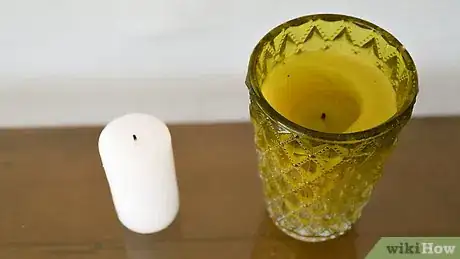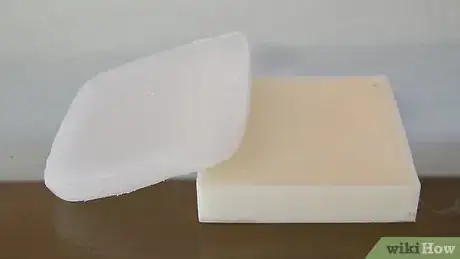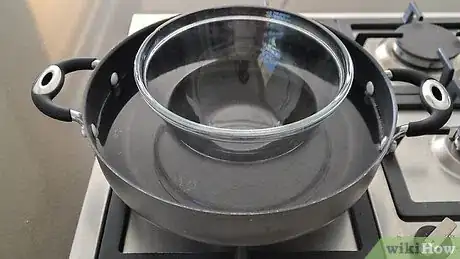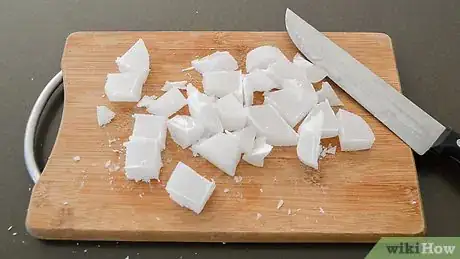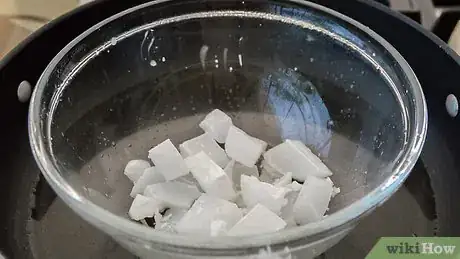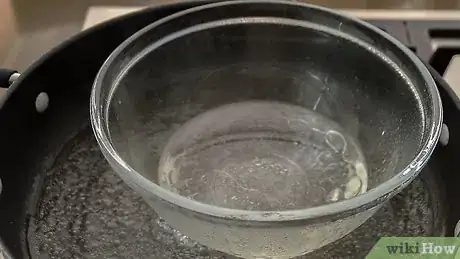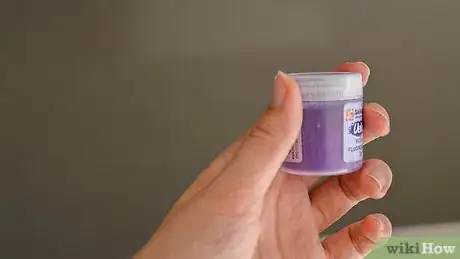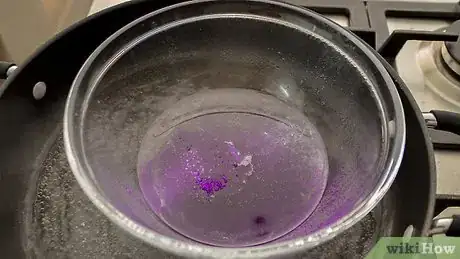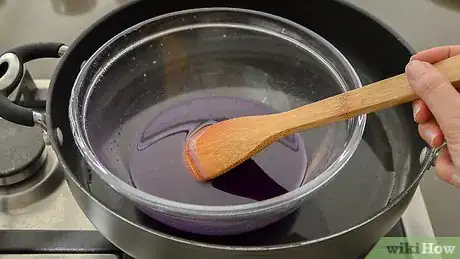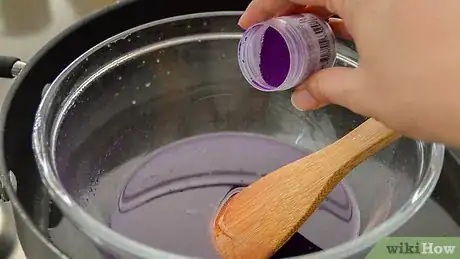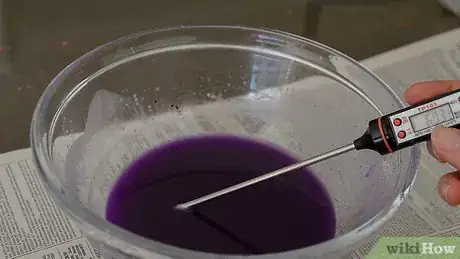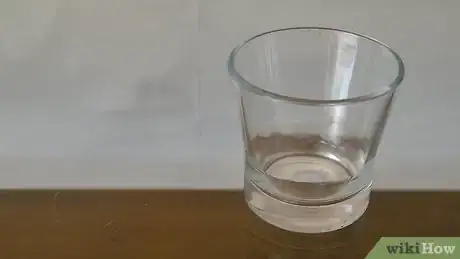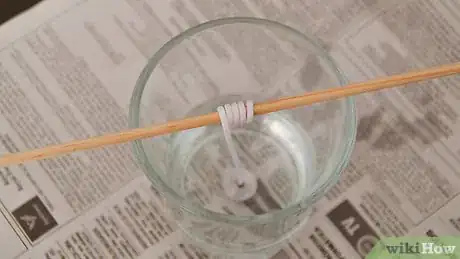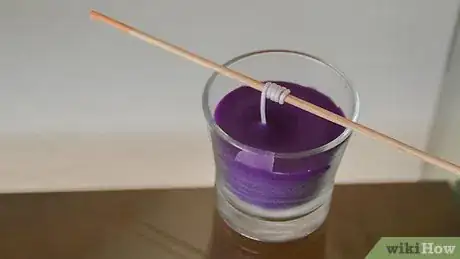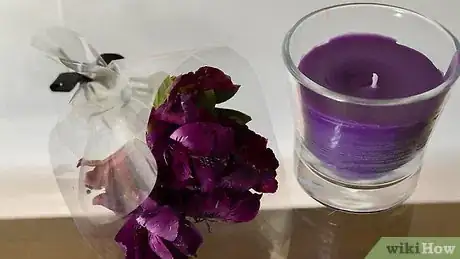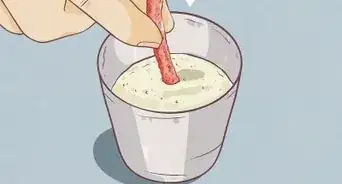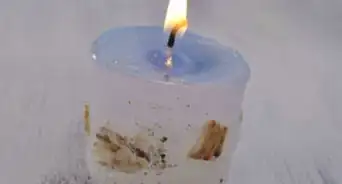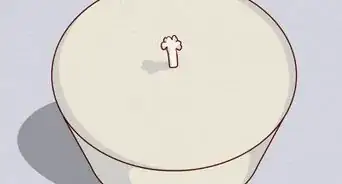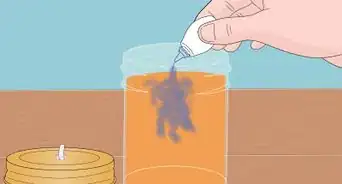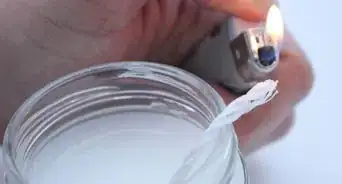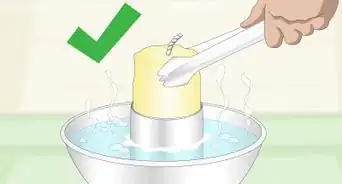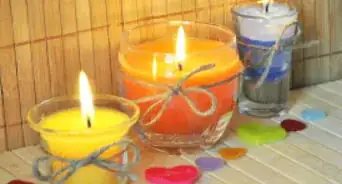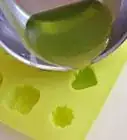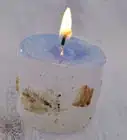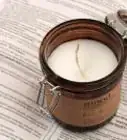This article was co-authored by Claire Donovan-Blackwood. Claire Donovan-Blackwood is an Arts & Crafts Specialist and CEO of Heart Handmade UK, a site dedicated to helping people live a happy, creative life. With over 13 years of experience, Claire uses art as a form of therapy and focuses on mindfulness in the making of art. She makes crafting easy and accessible for those she works with. Claire received her B.A. in Photography & Visual Imagery from The University of Huddersfield.
There are 12 references cited in this article, which can be found at the bottom of the page.
This article has been viewed 156,347 times.
There’s only one thing that could make your favorite candle even better—if it were your favorite color, too! Dyeing your candles allows you to customize them to suit any set of sensibilities. Start by melting an old candle or two on the stovetop in a double boiler, or use a block of paraffin wax to make your own candles from scratch. Add a small amount of powdered or liquid candle dye, stirring in more pigment gradually until you achieve the desired shade. Once the wax is just the right color, pour it into an empty mold complete with a new wick and allow it to harden.
Steps
Melting the Wax
-
1Pick out an old candle to upgrade. White and other light shades will allow the dye to show up better, yielding the most vibrant results. Since you'll be melting them down, it will be easiest to work with plain container-less candles. If the candle you want to use is in a jar or tin, use a butter knife to scrape out the wax in chunks.[1]
- You can use multiple smaller candles to create one big candle, as long as they're all made from the same type of wax.
- The candle you choose should not contain any other decorative elements such as flowers, seashells, or glitter.
- Avoid using scented candles. Melting these down can affect the perfumes that have been added to the wax, causing them to take on an unpleasant fragrance.
-
2Buy a few blocks of paraffin wax to make your own candles. If you’d prefer to mold a new candle from scratch, purchase a package of paraffin blocks. Paraffin is one of the easiest varieties of wax to melt and recolor. Raw wax and other candle-making supplies can usually be found at arts and crafts stores.[2]
- Soy or beeswax chips may also be available, if you’re particular about the type of wax you use.
- While you’re doing your shopping, make sure you pick up enough uncut wicks for each candle to have at least one.
Advertisement -
3Set up a double boiler to heat the wax. If you don’t own a double boiler, fill a large pot halfway up with water and begin warming it over medium-high heat. Then, situate a second heat-safe container, like a glass mixing bowl or measuring cup, inside the first so that it hovers just above the water bath. The pot will transfer heat to the smaller container without letting it get too intense.
- You can also use a metal coffee can or similar container if you’d rather not have to clean candle wax out of your cookware after completing the project.
- Never expose wax to direct heat. This could ruin its natural consistency or even cause a fire![3]
-
4Cut the candles or wax blocks into pieces. Use a sharp knife to break the wax up into 1-inch (2.5-cm) cubes or create shavings. This will increase its overall surface area, helping it melt faster. The smaller the pieces, the less time it will take for the wax to liquefy.
- Set the candles or blocks on a cutting board to avoid scarring your work surface.
- Be careful when handling the knife. Candle wax is an oily substance, which means it may be a little slick.
-
5Add the wax to the boiler. Place the cut-up candle you want to dye into the smaller container hovering above the water bath. If you’re using raw paraffin, drop in 2-5 blocks, depending on how many candles you want to make and how big you intend them to be. These can also be cut into more compact pieces to speed up the melting process.[4]
- 2-2.5 blocks of paraffin can be used to make a standard jar candle, while 5 blocks will produce an oversized candle closer in dimension to a quart-sized milk carton.
-
6Melt the wax down to a liquid. Stir the semisolid wax periodically to break up lumps. It will typically begin to soften within about 5 minutes and liquefy completely in 8-10. By the time it melts, it will have become thin, transparent, and totally smooth. This is how you’ll know it’s ready to accept the dye.[5]
- Use a thin, disposable utensil like a wooden dowel or popsicle stick to do your stirring.
- It may take 2-3 minutes longer for the same quantity of a harder wax like paraffin or beeswax to melt completely.
Adding Color
-
1Purchase a suitable candle dye. Many candle companies sell liquid dyes that are specifically designed to be used with their products. Other all-purpose dyes will successfully color almost any candle. The important thing is that you choose an appropriate dye for the type of wax you’re working with. Otherwise, it may not blend properly.[6]
- Powdered dyes and pigments, such as Rit Dye, can be useful for dyeing candles.
- Avoid ordinary liquid dyes like food coloring. When combined, the watery dye and oily wax will separate, producing an unsightly splotchy effect.[7]
- To keep things simple, you can even use crayons. Since both the candle and the crayon are made of wax, they’ll blend like a dream.
-
2Add a small amount of dye to the melted wax. Squeeze in a few drops, or shake in 2-3 teaspoons if you’re working with a powdered dye. Be careful not to oversaturate the wax—candle dyes tend to be extremely concentrated, so a little bit goes a long way.[8]
- The exact amount you use will depend on the size and number of candles you’re making, as well as the depth of color you’re aiming for.
- Dyeing with crayons couldn’t be easier. Just peel off the paper label, drop in as many pieces of the crayon as needed, and stir![9]
-
3Stir the dyed wax thoroughly for 2 minutes. Keep your stirrer moving slowly and continuously through the melted wax. This will ensure that the dye gets distributed evenly. Once the color is uniform throughout, stop and determine whether it’s dark enough for your liking.
- Try not to stir too fast, or you could end up splattering wax all over your work area.
-
4Add more dye gradually until you achieve the desired color. The more you use, the bolder and more vibrant the finished candle will be. Creating darker shades like hunter green or navy blue may require you to use double or even triple the amount of dye that you ordinarily would. Remember to stir constantly while pouring in the pigment.
- A good rule of thumb for estimating how much dye to add is to multiply the total batch size by 0.05%. To color 1 pound (450 g) of wax, for example, you would need to use 0.227g of dye.[10]
-
5Allow the wax to cool to 135–140 °F (57–60 °C). When you're satisfied with the quality of the color, turn off the boiler and remove the melting container from the heat. The wax will need to cool slightly before it can be poured into the new mold. Use a kitchen thermometer to test the temperature of the wax as it sits.[11]
- Pouring wax at temperatures higher than about 140 °F (60 °C) may cause frosting or shrinkage, or even shatter glass containers.[12]
Pouring the New Candle
-
1Select a container for the new candle. If you’re dyeing an old candle, the easiest option is to simply reuse the original jar. However, almost any type of container will work, provided it’s heat-safe, has an open mouth, and is large enough to hold the melted wax. Metal cans, shot glasses, tea cups, and mason jars can all make great DIY candle molds.[13]
- Use gelatin molds or empty tea light holders to pour multiple miniature candles.
- To make free-standing candles with the wax exposed, try cutting the top off of a quart-sized milk carton. You can then tear the cardboard away once the wax has set.[14]
-
2Position the wick in the empty mold. Take an uncut wick and tie one end around a wooden dowel or pencil. The opposite end should be just long enough to reach the bottom of the container. Set the dowel over the open mouth so that the wick is perfectly centered and hanging straight down.[15]
- A wooden clothespin or strip of tape can also make a decent wick holder in a pinch.[16]
- To create a double wick for a larger candle, simply tie a second wick 1.5–2 inches (3.8–5.1 cm) away from the first.
-
3Pour the wax into the mold. To keep from making a mess, it may help to grab a funnel or transfer the wax to a separate container that has a pour spout. Be sure to leave about 1⁄2 inch (1.3 cm) of space at the top of the mold so there will be room for the melted wax to collect as the candle burns.[17]
- Use leftover wax to make smaller candles, or wait until it dries to scrape it out and dispose of it.
-
4Allow the wax to set up. It may take up to an hour for the wax to solidify completely. As it does, it will assume the shape of the surrounding container and you’ll have a brand new homemade candle in your favorite color. In the meantime, avoid touching the wax. Doing so could leave behind depressions, smudges, or other imperfections.[18]
- Be careful not to disturb the wick while the wax is setting up, as well.
- Placing the freshly-poured candle in the refrigerator or leaving it in another cool area may help speed up the hardening process.
-
5Trim the wick. Untie or cut the wick from the dowel. Take a pair of scissors and snip the wick about 1⁄4 inch (0.64 cm) from the surface of the wax. Your new candle will then be ready to light and add a warm glow to any room![19]
- Clipping the wick too short may make the candle difficult to light, while leaving it too long will cause it to burn inefficiently.
Community Q&A
-
QuestionCan you use food coloring to dye candles?
 wikiHow Staff EditorThis answer was written by one of our trained team of researchers who validated it for accuracy and comprehensiveness.
wikiHow Staff EditorThis answer was written by one of our trained team of researchers who validated it for accuracy and comprehensiveness.
Staff Answer wikiHow Staff EditorStaff AnswerLiquid food coloring won’t work, because it is water based and will not mix with the oils in the wax. However, you can use gel or paste food coloring. Powdered food coloring may also work.
wikiHow Staff EditorStaff AnswerLiquid food coloring won’t work, because it is water based and will not mix with the oils in the wax. However, you can use gel or paste food coloring. Powdered food coloring may also work. -
QuestionHow do you color candle wax naturally?
 wikiHow Staff EditorThis answer was written by one of our trained team of researchers who validated it for accuracy and comprehensiveness.
wikiHow Staff EditorThis answer was written by one of our trained team of researchers who validated it for accuracy and comprehensiveness.
Staff Answer wikiHow Staff EditorStaff AnswerOne way is to infuse the wax with colorful herbs. Put powdered herbs such as alkanet, madder root, or spirulina into coffee filters and make them into bundles using twist ties. Place each bundle into a glass jar filled with melted wax. Put the jars in a water bath in a slow cooker on low for 24 hours. The tint from the herbs should soak through the coffee filters and color the wax.
wikiHow Staff EditorStaff AnswerOne way is to infuse the wax with colorful herbs. Put powdered herbs such as alkanet, madder root, or spirulina into coffee filters and make them into bundles using twist ties. Place each bundle into a glass jar filled with melted wax. Put the jars in a water bath in a slow cooker on low for 24 hours. The tint from the herbs should soak through the coffee filters and color the wax. -
QuestionCan you spray paint candles?
 wikiHow Staff EditorThis answer was written by one of our trained team of researchers who validated it for accuracy and comprehensiveness.
wikiHow Staff EditorThis answer was written by one of our trained team of researchers who validated it for accuracy and comprehensiveness.
Staff Answer wikiHow Staff EditorStaff AnswerGenerally, this is not a good idea. The paint can release unpleasant or dangerous fumes when you burn the candle.
wikiHow Staff EditorStaff AnswerGenerally, this is not a good idea. The paint can release unpleasant or dangerous fumes when you burn the candle.
Warnings
- Keep an eye on your wax the whole time it’s on the stove. Accidents happen when you get distracted.⧼thumbs_response⧽
Things You'll Need
- Old candles
- Raw paraffin, soy, or beeswax (optional)
- Crayons (optional)
- Double boiler (or large pot and smaller heat-safe container)
- Liquid or powdered candle dye
- Uncut candle wicks
- Wooden dowel, clothespin, or tape
- Knife
- Scissors
- Containers of various sizes and materials (for pour candles)
References
- ↑ https://www.youtube.com/watch?v=T7tQupVQ1Ws&feature=youtu.be&t=129
- ↑ https://www.ritdye.com/2015/12/04/how-to-make-molded-candles-with-rit-powder-dye/#!
- ↑ https://www.fragrancex.com/fragrance-information/a-candle-making.html
- ↑ https://www.ritdye.com/2015/12/04/how-to-make-molded-candles-with-rit-powder-dye/#!
- ↑ https://www.fragrancex.com/fragrance-information/a-candle-making.html
- ↑ http://www.howtomakecandles.info/cm_article.asp?ID=DYE0001
- ↑ https://www.youtube.com/watch?v=Tgkxo6GginA&feature=youtu.be&t=97
- ↑ http://www.cierracandles.com/how-to-use-liquid-candle-dye.html
- ↑ https://craftingagreenworld.com/articles/how-to-dye-wax-with-crayons/
- ↑ http://www.cierracandles.com/how-to-use-liquid-candle-dye.html
- ↑ https://www.youtube.com/watch?v=HM8dpgA-bms&feature=youtu.be&t=82
- ↑ https://www.candlescience.com/learning/how-to-make-a-soy-candle
- ↑ https://food52.com/blog/14170-how-to-make-soy-candles-from-any-containers-you-have-on-hand
- ↑ https://www.ritdye.com/2015/12/04/how-to-make-molded-candles-with-rit-powder-dye/#!
- ↑ https://www.kristendukephotography.com/diy-scentsy-candle/
- ↑ https://candletech.com/candle-making/how-to-make-container-candles/
- ↑ https://www.youtube.com/watch?v=HM8dpgA-bms&feature=youtu.be&t=82
- ↑ https://www.ritdye.com/2015/12/04/how-to-make-molded-candles-with-rit-powder-dye/#!
- ↑ https://candletech.com/candle-making/how-to-make-container-candles/
About This Article
If you want to dye your own candles, you’ll need paraffin wax or an old candle, powdered dye, a candle mold, a wick, and a double boiler. If you don’t have a double boiler, you can set a bowl over a pan of boiling water instead. Start by cutting your wax into 1-inch blocks and melting it in your double boiler. Then, add drops of dye until you reach your desired color. Stir the wax for 2 minutes, then pour it into the empty candle mold with the wick in the middle. Let it sit for 1 hour, and you're done! For more tips, including how to position the wick in your candle mold, read on!
